 Image search results - "Prefecture" Image search results - "Prefecture" |
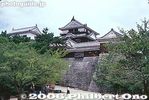
Matsuyama Castle
|
|
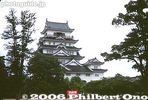
Fukuyama Castle tower
|
|
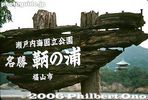
Sign for Tomonoura. Tomonoura is a National Important Traditional Townscape Preservation District (重要伝統的建造物群保存地区).
|
|
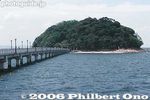
Takeshima island is connected by a bridge. The island is uninhabited, but has a Yaotomi Jinja Shinto shrine (八百富神社) dedicated to goddess Takeshima Benten. Designated as a Natural Monument for its flora which greatly differs from that on shore.
|
|

Sign for boat going to the islands (no longer in service)
|
|

Okazaki Castle towerThe castle was dismantled during the Meiji Period and the area was made into a castle park. The castle tower was later rebuilt in 1959.
|
|
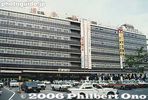
Hakata Station, gateway to Kyushu
|
|
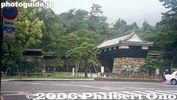
Yamauchi Kazutoyo's castle. My Contax compact film camera had a bad lens day, making the images foggy.
|
|

Uwajima Station
|
|

Uwajima Castle tower (Important Cultural Property), Ehime Prefecture.
|
|
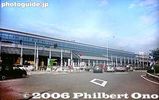
Imabari Station
|
|
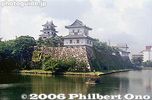
Originally built in 1604 by Lord Takatora Todo, Imabari Castle today is still a very good castle complex with great views of the city and Inland Sea. The castle tower was reconstructed in 1980. 今治城Unfortunately, my camera lens had a fogging problem.
|
|

Occupying a huge plot of land in the center of the city, Kanazawa Castle has undergone extensive renovations and reconstruction. The main castle buildings are now magnificently restored.
|
|
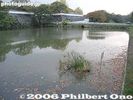
Castle moat
|
|
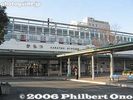
JR Karatsu Station
|
|

Torokko train at Arashiyama for Hozu Gorge
|
|

Kameyama Castle is now headquarters to a religion called Omoto-kyo which acquired the castle property in 1919. Only stone walls and moats remain.Statue of shachihoko.
|
|
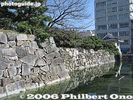
Higo Moat and turret (?)This is near the Karatsu City Hall. From Karatsu Station, it takes about 25 min. to walk to the castle tower.
肥後堀
|
|

Kakegawa Castle as seen from the train
|
|

Kakegawa Station, south entrance
|
|

Road to Himeji Castle. From Himeji Station, the main road leads to the castle which can be seen in the distance.
|
|

Akashi StationOn the JR Sanyo Line.
|
|

Nijo-jo castle was built on the order of Tokugawa Ieyasu to serve as the Kyoto residence for the Tokugawa shoguns. Although it does not have a castle tower, Nijo-jo Castle is Japan's best preserved and most magnificent castle palace.Seinan-sumi (Southwest corner) Turret is the first castle building you see when you walk from the station. Important Cultural Property 西南隅櫓
|
|

Akashi Castle seen from the train platform of Akashi Station.
|
|

Inuyama Yuen Station. Closest station to Inuyama Castle on the Meitetsu Line.
|
|

Road to Inuyama Castle
|
|

A symbol of Osaka and one of Japan's largest reconstructed castles. Originally built by Toyotomi Hideyoshi in 1583. The castle tower was reconstructed in 1931 and underwent major renovation during 1995-97 and serves as a very modern history museum. Closest station is Osaka-jo Koen Station.
|
|

Road marker. Established in 1642, Moriyama-juku was the sixty-seventh of the sixty-nine stations or shukuba post towns on the Nakasendo Road. It is the eighth Nakasendo station in Shiga (following Musa-juku in Omi-Hachiman).
|
|

On the Sunday before the second Monday of Jan., 33 hectares of a hill called Wakakusa-yama (seen in the distance here) next to Nara Park is burned at night.The burning hill looks more spectacular from afar, but we went up close.
|
|

JR Nagano Station festooned with Olympic logos.
|
|

Entrance to castle tower
|
|

Fukuyama Castle tower
|
|

Ferry between Tomonoura and Sensui island.
|
|
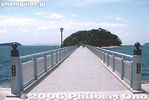
400-meter long bridge to Takeshima island near JR Gamagori Station. The island is made of granite. Circumference is 680 meters. There's a walking path around the island.
|
|

Rabbit Island
|
|
|

Near the castle gate
|
|
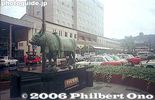
Fighting bull statue in front of Uwajima Station.
|
|

Castle tower
|
|
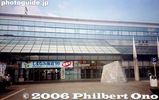
Imabari Station
|
|
|
|

Kanazawa Castle was the base for the Kaga Domain (Ishikawa and Toyama Prefectures) ruled by the Maeda clan 1583–1871 starting with Maeda Toshiie.
|
|
|
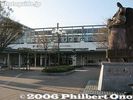
JR Karatsu Station
|
|
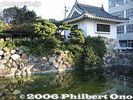
Turret (?)
|
|
|

Kameyama Castle was built by Akechi Mitsuhide in the 16th century as his base for his conquered Tanba region.
|
|

Being my first regatta, I was at first daunted by the rowing terminology for the different types of boats.
|
|

Kakegawa Station, north entrance
|
|

Yotsuashi-mon GateMain gate to enter the castle grounds. A reconstruction.
四足門
|
|

Road to Himeji Castle. Otemae Boulevard (Symbol Road). 大手前通り
|
|
|

Akashi Castle seen from the train platform of Akashi Station.
|
|

Kiso River with Inuyama Castle in the distance
|
|

Inuyama Cultural History Museum犬山市文化史料館
|
|

The original Osaka Castle built by Toyotomi Hideyoshi was actually buried (smothered) by the Tokugawa and a new castle was built on it. Aoya-mon Gate 青屋門. Rebuilt in 1970.
|
|

Road marker. Go right for the Nakasendo Road. MAP
|
|

Wakakusa-yama hill in JanuaryWakakusa-yama hill actually has three hills. We see only the first one here.
|
|

Welcome sign at Nagano Station
|
|
|
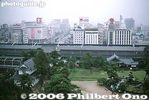
View from castle tower
|
|
|

Torii on Takeshima island
|
|
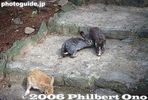
Rabbits
|
|
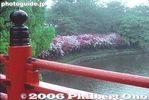
Bridge and azaleas
|
|
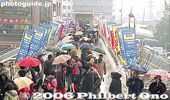
Nagano Station, East Exit to Olympic PlazaAt the East Exit of Nagano Station, this bridge, lined with advertising banners, led the way to the Olympic Plaza which featured ten tent pavilions made by official sponsors.
|
|
|
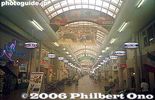
Shopping arcade
|
|

Inside Uwajima Castle tower.
|
|
|
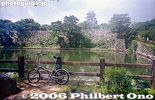
My bicycle
|
|
|
|
|

Kunchi monument at Karatsu StationKaratsu's most famous festival is the Hikiyama Kunchi Festival where large floats are paraded around.
|
|

The turret turned out to be a public toilet...Looked nice enough to photograph, but when I walked around it, it smelled like the toilet it was.
|
|
|

Statue of shachihoko roof ornament
|
|

Carrying back a single sculling boat
|
|

Main street in front of station
|
|

Steps to the castle tower
|
|

Uchibori Inner Moat
|
|

Minami-mon (South) Gate 南門
|
|

Inuyama Castle
|
|

Karakuri Doll Museumからくり展示館
|
|

Aoya-mon GateRebuilt in 1970. Although this is not the main or front gate, it is the closest castle gate to Osaka-jo Koen Station.
青屋門
|
|

Rear of road marker
|
|

Dry grass ready to burn...
|
|
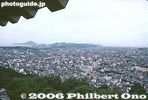
View from top floor
|
|
|
|
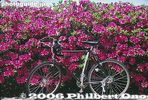
My bicycle somewhere in Gamagori.
|
|

Feeding a rabbit
|
|

Azaleas
|
|
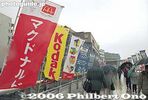
To Olympic Plaza
|
|
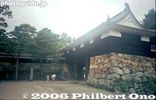
Castle gate
|
|
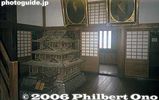
Inside castle tower
|
|
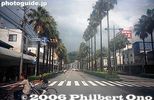
Main road in Uwajima
|
|
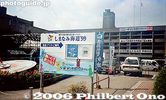
City Hall
|
|
|
|
|

Higo Moat
|
|
|
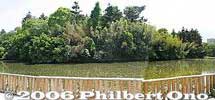
Castle compound and moat
|
|
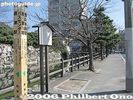
Sightseeing marker in English
|
|

Fukuyama Castle from the train
|
|

The place was not as crowded as you would think.
|
|

Kakegawa, Shizuoka
|
|
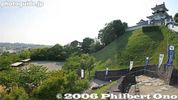
Castle tower
|
|

Castle moat
|
|

Castle moat
|
|

Tonan-sumi (Southeast corner) Turret, Important Cultural Property 東南隅櫓
|
|

Inuyama Castle
|
|

Karakuri Doll MuseumThe karakuri dolls, set atop ornate floats, are controlled with strings.
|
|
|

Marker for the Kabuto-ya inn
|
|

Volunteer firemenThe hill set alight by 300 volunteer firemen and prefectural workers who climb up the hill.
|
|

View from top floor
|
|

Bentenjima island near Tomonoura.
|
|

JR Gamagori Station. In the foreground is my bicycle.
|
|

Rabbit Island
|
|
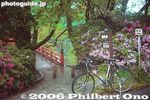
Bridge to caslte
|
|

Pavilion by Kirin Brewery.Notice the "wrap" bus passing in front.
|
|
|
|

View from top floor
|
|

Imabari Castle 今治城
|
|
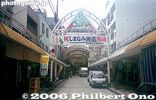
Shopping arcade with Shimanami bannerImabari is on one end of the bridges linking Shikoku and Honshu.
|
|

Highway in front of the castle.
|
|
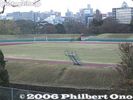
Heiwadai Track and Field arena
|
|
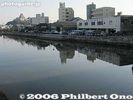
River and castle in the distance
|
|

Hozu River
|
|

Castle moat
|
|
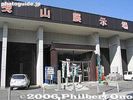
Hikiyama Float Exhibition Hall曳山展示場
|
|
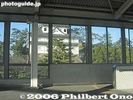
Fukuyama Station (shinkansen)
|
|

Rowing team from Nagahama
|
|

Stairs to Kakegawa Castle tower
|
|

Path to Otemon Gate, the main gate to the castle. 大手門
|
|

Shimizu Bank
|
|

Entrance to Akashi Park
|
|

Tonan-sumi (Southeast corner) Turret 東南隅櫓
|
|

Haritsuna Shrine
|
|

Entrance to Urakuen GardenThis garden has a few tea houses including one called Jo-an, a National Treasure. THe garden is close to Inuyama Castle and worth a visit. Admission 1,000 yen.
有楽苑
営業時間 9:00〜17:00(3/1〜7/14 ・ 9/1〜11/30)
9:00〜18:00(7/15〜8/31)
9:00〜16:00(12/1〜2/末日)
休日 無休 入場料 大人1,000円(呈茶別500円)
〒484−0081
愛知県犬山市御門先1
TEL 0568(61)4608
交通 名鉄犬山線犬山遊園下車徒歩7分
|
|

Inner moat
|
|

Old Nakasendo Road and Dobashi Bridge. Supposedly, this is the bridge from where Hiroshige drew his print of Moriyama-juku.
|
|

Bamboo torches and bamboo broomsThe bamboo torches is filled with kerosene and plugged with cotton cloth. They are used to set the hill afire. The bamboo brooms are used to spread the fire or extinguish it. The brooms burn up by the end of the festival.
|
|
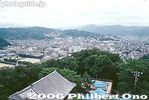
View from top floor
|
|
|
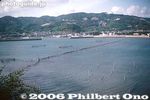
View from Rabbit Island
|
|
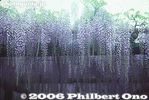
Wisteria
|
|

Olympic PlazaSnowlets House and Kodak's pavilion behind it.
|
|

Kochi Castle tower
|
|
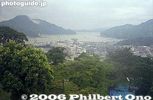
View from top floor
|
|

Shopping arcade
|
|
|

Outer castle wall
|
|
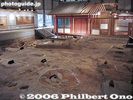
Korokan ruinsThe Korokan was a Heian-Period guest house for foreign dignitaries and diplomats.
鴻臚館跡
|
|

Bridge to castle城内橋
|
|

Hozu Gorge
|
|
|
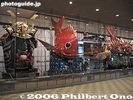
Inside Hikiyama Float Exhibition HallKunchi festival floats are displayed.
曳山展示場
|
|
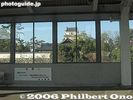
Fukuyama Station (shinkansen)
|
|
|

Otemon Gate, Main gate to castle. Reconstructed in 1937. 大手門
|
|

Shimizu Bank
|
|

Castle moat
|
|

Tonan-sumi (Southeast corner) Turret 東南隅櫓
|
|

Sanko Inari ShrineThe shrine provides a short cut to the castle.
|
|

Urakuen Garden水琴窟
|
|
|
|

Dobashi Bridge
|
|

Bamboo torches and bamboo broomsThe bamboo torches is filled with kerosene and plugged with cotton cloth. They are used to set the hill afire. The bamboo brooms are used to spread the fire or extinguish it. The brooms burn up by the end of the festival.
|
|
|
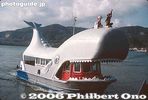
Boat to Rabbit and Monkey islands (no longer in service)
|
|
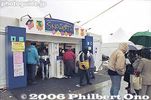
Entrance to Snowlets House at Olympic Plaza.The official store for Olympic souvenirs. There were a lot of ticket scalpers (all foreigners) hanging around the entrance. Inside, there was a ticket counter for events which still had seats.
|
|

Kochi Castle tower
|
|
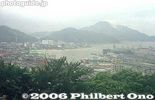
View of Uwajima city from top floor
|
|
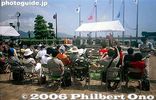
Near the waterfront
|
|
|
|
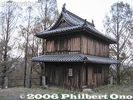
Fukuoka Castle, Kinen Turret祈念櫓
|
|
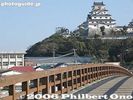
Jonai Bridge to castle城内橋
|
|
|

Entrance to Omoto-kyo HQ and former castle grounds
|
|
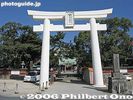
Karatsu Shrine
|
|
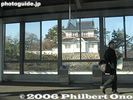
Fukuyama Station (shinkansen)
|
|

Azaleas in full bloom along the lake edge
|
|

Final gate to Castle tower
|
|

Shimizu Bank's relief of Kazutoyo and Chiyo
|
|

World Heritage Site marker. 世界遺産 姫路城
|
|

Twin turrets of Akashi Castle
|
|

Tonan-sumi (Southeast corner) Turret 東南隅櫓
|
|

Steps to castle gate
|
|

Urakuen Garden tea ceremony house
|
|

In 2006, a rare folding screen painting showing Osaka Castle during Hideyoshi's years in early 17th century was found at Schloss Eggenberg Castle in Austria.http://www.museum-joanneum.at/en/schloss_eggenberg/saka-zu-bybu-1
|
|

Tomon-in temple built by Buddhist Priest Saicho (Dengyo Daishi) to protect his Enryakuji temple on Mt. Hiei from demons from the east. 東門院
|
|

Bamboo torchesThe bamboo torches is filled with kerosene and plugged with cotton cloth. They are used to set the hill afire.
|
|
|
|

Monkey Island (Sarugashima)
|
|
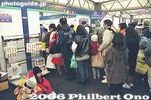
Snowlets HouseIt was packed. This is part of the checkout line. There were four checkout lines and each one was about 30 meters long. The line went pretty fast though. They had all kinds of souvenirs: T-shirts, sweatshirts, flags, postcards, pins, key chains, necklaces, stuffed Snowlets, mugs, and even jewelry. I went on the 6th day of the Games and it still had everything well in stock. But I later heard that the shelves were laid bare well before the Games ended.
|
|
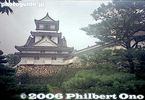
Kochi Castle tower
|
|
|
|

Castle tower entranceThe castle tower is a local history museum.
|
|
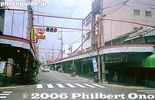
Street near waterfront
|
|

Ishikawa Bridge to Ishikawa-mon Gate
|
|
|
|
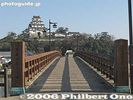
Jonai Bridge to castle城内橋
|
|

Train station platform
|
|
|
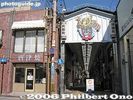
Gofuku-cho shopping arcade
|
|

Fukuyama Station (shinkansen)
|
|
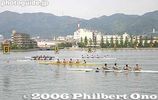
Four-man boat race. There were also foreign rowers from international schools.
|
|

View of castle palace
|
|

World Heritage Site marker. 世界遺産 姫路城
|
|

Shopping street
|
|

Twin turrets of Akashi CastleThe left turret is called the Hitsujisaru Turret (坤櫓) and the right one is called the Tatsumi Turret (巽櫓).
|
|

Tonan-sumi (Southeast corner) Turret 東南隅櫓
|
|

Steps to castle gate
|
|

Inside Jo-an tea ceremony house, a National Treasure
|
|

Gokuraku-bashi BridgeMeans Paradise Bridge. The original bridge was wooden. Rebuilt in 1965. It connects the Yamazato-maru section with the Ninomaru section.
極楽橋
|
|

Kaeru frog to wish you a safe return. 東門院
|
|

The deer have no idea what danger they are in...
|
|
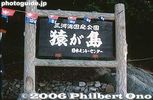
Monkey Island (Sarugashima)
|
|
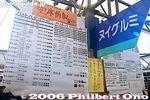
Snowlets House, ticket availability
|
|
|
|
|
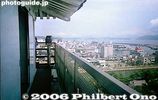
Top floor balcony
|
|

Main road from the train station
|
|

Ishikawa-mon Gate 石川門
|
|
|
|
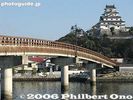
Jonai Bridge to Karatsu Castle城内橋
|
|

Shooting the rapids
|
|
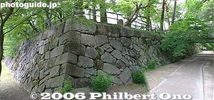
Stone foundation
|
|

Gofuku-cho shopping arcade
|
|

Cheering section for Nagahama
|
|

View of Honmaru
|
|

San no Maru. This area is ringed by cherry trees. 三の丸広場
|
|

Shopping street
|
|

Hitsujisaru Turret (坤櫓)
|
|
|

Reconstructed Honmaru Gate
|
|

Jo-an tea ceremony house, a National Treasure. Built in 1618 by Oda Uraku, one of the greatest tea ceremony masters and younger brother of warlord Oda Nobunaga.Jo-an is one of Japan's three most famous tea ceremony houses. 如庵
|
|

Gokuraku-bashi Bridge
|
|

樹下神社
|
|

Water bagsThe third item the volunteer firemen carry are water bags. The water bag is filled with water weighing 20 kg or so. A nozzle is also attached. It is used to extinguish the fire.
|
|

JR Kami-Suwa Station
|
|

Castle tower
|
|

Lake SuwaYou can rent a bicycle at Kami-Suwa Station and ride along the lake shore.
|
|

Ishibe-juku was the 51st stage/post or shukuba lodging town on the Tokaido Road where even Emperor Meiji once stayed (with an entourage of over 3,000). View from JR Ishibe Station. Ishibe in Konan city is rural, yet it has a few major industries operating.
|
|

Meaning "Long Life Temple," Chojuji's Hondo temple hall is a National Treasure. It belongs to the Tendai Buddhist Sect and one of the Konan Sanzan Temple Trio along with Jorakuji and Zensuiji Temples.Chojuji temple Entrance gate + fall colors.
|
|

A stone's throw from Chojuji Temple, Jorakuji Temple (est. 708) of the Tendai Buddhist Sect boasts two National Treasures with its main hall and three-story pagoda. It is one of the Konan Sanzan Temple Trio accessible by bus from JR Ishibe Station.In the deep-green forest, you can see part of the pagoda's roof.
|
|

At 271 meters high, Mt.Hachiman-yama was the site of Hachiman Castle built by Toyotomi Hidetsugu in 1585. Now home to Zuiryuji temple of the Nichiren Sect, some of the castle's stone walls still remain. MAP
|
|

Inside Ritto Station and sign celebrating the decision to build a shinkansen station in Ritto. Celebration has been muted after the new governor was elected in July 2006.
|
|
| 2221 files on 9 page(s) |
1 |
 |
 |
 |
 |
|